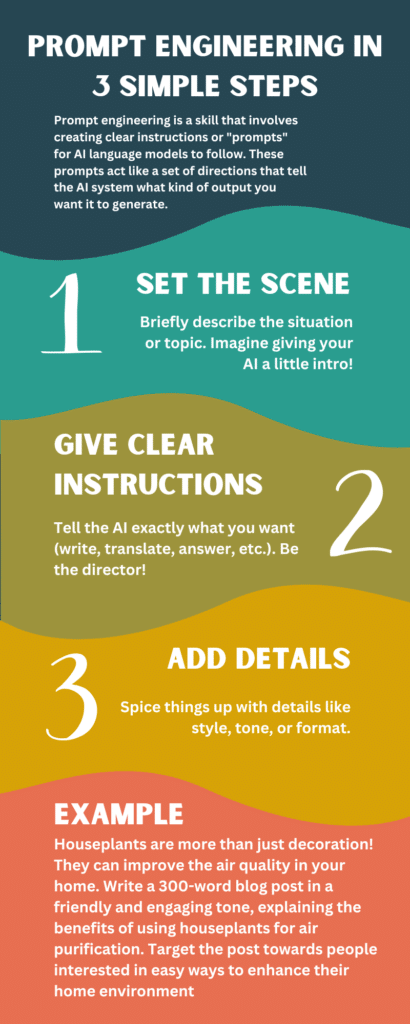
Artificial intelligence (AI) models like ChatGPT and DALL-E have taken the world by storm with their ability to understand and respond to human prompts. But have you ever wondered how these models learn to comprehend and follow our instructions so effectively? The answer lies in a crucial process called prompt engineering.
Prompt engineering is not that difficult. It involves crafting clear instructions for large language models (LLMs) to achieve your desired outcome. Learning the basic structure of prompts (context, instruction, details) takes minutes. However, mastering the nuances and fine-tuning prompts for specific tasks can involve ongoing exploration and practice.
Prompt engineering is the art and science of creating clear, precise prompts that guide AI models to produce a desired output. Whether you’re looking to generate human-like text, create stunning visuals, or develop code, well-designed prompts are the key to unlocking the full potential of these powerful AI tools.
What is Prompt Engineering?
Prompt engineering is a skill that involves creating clear instructions or “prompts” for AI language models to follow. These prompts act like a set of directions that tell the AI system what kind of output you want it to generate.
For example, let’s say you want ChatGPT to write a short story for you. Simply asking “Write me a story” probably won’t give you a great result. The AI needs more specific information about what kind of story you want – the genre, characters, plot points, etc. Prompt engineering is all about providing those important details up front in your instructions.
Think of it like giving directions to a friend on how to bake a cake. If you say “Bake me a cake,” they might get confused. But if you give them a recipe with clear ingredients and step-by-step instructions, they’ll know exactly what to do. Prompts are the “recipe” that language models need to produce good outputs.
The better and more detailed your prompts are, the more likely the AI will understand your intent and generate something relevant and useful. That’s why developing skills in prompt engineering has become so valuable – it allows you to have more control and get better results when working with powerful AI tools.
Why is Prompt Engineering Important?
Prompt engineering is a key skill because it helps unlock the full potential of advanced AI language models like ChatGPT. Without clear and well-designed prompts, these systems won’t produce outputs that are truly useful or relevant to what you need.
Think about how frustrating it is when you ask someone for help, but they completely misunderstand what you’re asking for. The same thing happens with AI if your prompts are poorly written or lack important details. Good prompt engineering avoids confusion and increases the chances you’ll get an accurate, high-quality result.
There are three main reasons why mastering prompt engineering matters:
- It helps AI assistants better understand your intent and requirements. With a well-crafted prompt providing the right context, the AI knows exactly what kind of output you want it to create.
- Effective prompting allows you to steer and control the AI’s responses. You can refine the prompt to customize the length, tone, format, and other attributes.
- Using prompts strategically unlocks more capabilities from AI. You can create creative writing, analysis, coding, math skills, and more out of a single language model.
As AI tools become more widespread, being able to prompt them effectively will be a valuable skill. Those who invest time into learning prompt engineering will vastly increase their productivity and outputs when working with AI assistants.
Is Prompt Engineering Hard for Beginners?
Like any new skill, prompt engineering can seem challenging at first. After all, you’re learning how to communicate in a whole new language – the language that AI models understand best.
Some of the common challenges beginners face with prompt engineering include:
- Figuring out what makes a good prompt structure and format
- Avoiding unclear, ambiguous, or contradictory wording in prompts
- Providing enough relevant context and examples for the AI to work with
- Tweaking and refining prompts through trial and error until the outputs improve
However, the good news is that while there is a learning curve, prompt engineering fundamentals can be picked up relatively quickly. With some basic principles and hands-on practice, beginners can start leveling up their prompting abilities in no time.
The key is to be patient, experiment consistently, and pay close attention to what works and what doesn’t with different prompts. Every “unsuccessful” attempt is still a valuable learning experience.
Pretty soon, crafting clear prompts that generate high-quality AI outputs will start feeling like second nature. The more you engage in prompt engineering, the better you’ll become at this critical skill.
One of the things I did to learn, was sign up to ChatGPT(Free Version) and practice. I’ve spent a lot of time ‘playing’ with text prompts and although I’m ok, there is still plenty of room for improvement.
Prompt Engineering Best Practices
Even for beginners, there are some helpful strategies you can use to start improving your prompt engineering skills right away. Here are some best practices to keep in mind:
Start With a Clear Task
Before writing your prompt, get specific about what kind of output you want the AI model to generate. Do you need an essay, analysis, piece of creative writing, or something else? Clearly defining the task upfront will make it easier to craft an effective prompt.
Provide Relevant Context and Examples
Like giving directions to a friend, you’ll want to provide important context and examples in your prompt to orient the AI properly. The more relevant context you can give, the better the model can understand your intent and give you a relevant output.
Use Clear, Specific Language
When writing your prompt, avoid vague language, and be as clear and specific as possible. Using ambiguous words can easily confuse AI models. Stick to simple, concrete wording.
Structure Your Prompt Logically
Well-structured prompts that break down steps logically are easier for AI to comprehend. Use bullet points, numbered lists, or section headers to organize your prompt in a clear, linear fashion.
Iterate and Refine
Don’t be afraid to rephrase and tweak your prompts multiple times based on the results you’re getting from the AI. Prompt engineering often involves a process of trial-and-error refinement to achieve the desired output quality.
Study Effective Prompt Examples
Learn from others by analyzing prompt examples that generate high-quality outputs successfully. Seeing positive examples is a great way to improve your prompting abilities over time.
By consistently following these simple tips, you’ll be pleasantly surprised how quickly you can level up your prompt engineering skills as a beginner.
The Basic Structure of a Prompt

We’ve discussed how prompt engineering can unlock the power of large language models (LLMs), but how do you craft those magic instructions? Don’t worry, it’s not rocket science! Let’s break down the basic structure of a prompt into bite-sized pieces:
1. Setting the Scene (Context):
Imagine you’re telling a friend a story. You’d give them some background information first, right? The context in your prompt does the same for the LLM. This is where you briefly introduce the situation or topic at hand.
For example, if you want the LLM to write a poem, you might set the context with a line like “It’s a crisp autumn day, leaves are swirling in the wind…”
2. Giving Clear Instructions:
Now’s the time to tell the LLM exactly what you want it to do. Be clear and concise! Here are some common instructions you might use:
- Write: Use this for creative tasks like poems, scripts, or stories.
- Translate: Tell the LLM to translate text from one language to another.
- Answer: Looking for information? This is your go-to instruction for getting the LLM to answer your questions factually.
- Summarize: Need a quick rundown of a complex topic? Instruct the LLM to summarize a piece of text.
3. Adding Details (Optional):
Think of details as spices in your prompt recipe. They add flavor and guide the LLM towards a specific output. Here are some details you can include:
- Style: Want a funny poem or a formal report? Specify the desired style (e.g., “Write a humorous limerick”).
- Tone: Informative, persuasive, or lighthearted? Let the LLM know the tone you’re aiming for (e.g., “Answer the question in a friendly and informative tone”).
- Format: Do you need the output to be a specific length or format? Instruct the LLM accordingly (e.g., “Write a 5-sentence summary”).
Remember: The key is to be clear and concise. The more specific your instructions, the better the LLM will understand your request and deliver the desired results.
Bonus Tip: As you explore prompt engineering further, you might encounter terms like “few-shot learning” and “in-context learning.” These refer to advanced techniques for fine-tuning prompts but don’t worry about them for now. Focus on mastering the basic structure, and you’ll be well on your way to becoming a prompt engineering pro!
Prompt Engineering Tools and Resources: Level Up Your LLM Game!
Feeling like a prompt engineering pro after that basic breakdown? Awesome! But just like any skill, tools and resources are available to take your game to the next level.
Think of these as training wheels for your prompt-fu. Let’s explore a few popular options:
- Open Source Communities: Dive into the vibrant online world of prompt engineers! Platforms like [Reddit communities on Machine Learning] and [online forums on AI] are treasure troves of shared prompts, success stories, and troubleshooting tips. Plus, you can connect with other enthusiasts – it’s like having your own AI playground!
- Prompt Galleries and Search Engines: Feeling stuck on a specific task? Don’t reinvent the wheel! Websites like [Lexica] and [PromptBase] offer massive collections of user-generated prompts for various tasks and LLMs. Imagine it as a recipe book for crafting the perfect prompt!
- Interactive Platforms: Want to experiment without diving into code? Platforms like [Playground AI] allow you to directly input prompts, see the results, and even remix existing prompts to create something new. It’s a fantastic way to test different approaches and to understand how prompts influence the LLM’s output.
Remember, these are just a few starting points. As you explore further, you might find other tools and resources that suit your learning style. The important thing is to have fun and keep experimenting!
Conclusion
Prompt engineering is a valuable skill for working with modern AI language models effectively. While it has a learning curve, the basics can be picked up quickly through intentional practice. By starting with clear tasks, providing good context, using specific language and iterating prompts, anyone can become a better prompt engineer. The payoff is unlocking the full power of these remarkable AI tools.


